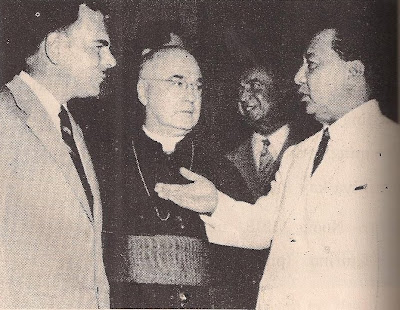Ramon F. Magsaysay
(1907 – 1957; president 1953 – 1957);
7th President of the Philippines
7th President of the Philippines
President of the Common Masses

“The only reward I desire for my service to our country is the trust given me by our countrymen.”
Ramon helped his father in their foundry and this maybe the reason for his well-built physique. Ramon finished his elementary education at Castillejos and continue his studies at Zambales Academy in San Narciso, Zambales. The required four years of his secondary education was finished by Ramon in only three years.
Ramon went to Manila in 1927 and enrolled at the College of Engineering at the University of the Philippines. While studying, Ramon is working so that he will no longer rely on the money that came from his parents. He believed that he could take care of himself. But soon however, Ramon got sick. According to the doctor who examined him, he got contracted with tuberculosis and immediately returned home. He got enough rest and eats nutritious food that will boost his energy. When he returns to Manila for school, he realized that he did not pass. He forgot to inform the school that he needs enough rest for his illness. Ramon decided to take commerce as his course to pursue his studies instead of engineering. He enrolled at Jose Rizal College. While studying, he worked as a driver to the owner of the house he is staying. He graduated in 1930. Although Ramon finished commerce, he never forgot his passion on machineries. He became a good mechanic. When he finished his studies, he became the manager of a workshop of Try-Tran Company, a mass transport company. His wage is 80 pesos a month.
During the war, Ramon joined the guerrilla movement and has the rank of captain. He became the eye of guerrillas. Magsaysay always reminds his comrades about the uncertainty of a successful campaign. He often said:
“My brothers, you already know the cause of our power to bond like this. We are fighting now not only for our own freedom but also the freedom of our children and our children’s children.” As the leader of the troop, Magsaysay was loved and respected by his men. Because of his sincere and loyal service, his troop has become faithful to him as well. Once the Japanese offered the Filipino people 100,000 pesos to anyone who could lead them to locate Magsaysay, then he said “People can do nothing but to point me so they can obtain such money… but they never do it. I’d proven it before that if you want to be successful; you need the people to side with you.”
Magsaysay left the movement in February, 1946. In the election of 1946, he became a representative of Zambales in Congress. He was reelected in 1949. On September 1, 1950, Magsaysay was appointed by President Quirino as secretary of the National Defense department. Magsaysay regained the trust of the people to the Armed Forces of the Philippines. His ability as a leader boost the morale of the men in uniform.
On November 10, 1953, as a symbol of gratitude and worth given by his countrymen to him, Magsaysay was elected President of the Philippines. As president of the country, Malacañan, was opened to the public. For the first time, the general public can freely visit the palace.
As president he once said: “My only standard of service to the government is austerity in spending, and honesty in service that is joined by honor of service to the nation. We need to bring to the people the real meaning of the word democracy…”
At his visit in a wet market in Manila one time, President Magsaysay saddened by what he saw and said: “I had been a part of the struggles of the men and women who are present here today. I know that for them, to live is a never ending struggle to be comfortable from dawn till dusk. I understand the feeling they have in their heart and I feel the burden on their shoulders. Now that I am in position to help them, I will do my best to ease their burden… I have a strong faith that a man, no matter how small, has a right to feed his stomach and shelter his head.”
President Magsaysay’s wife is Luz Banzon of Bataan who bore him three children namely Teresita, Milagros and Ramon. Ramon is a former representative and senator. It’s a great loss for every Filipino the early death of President Magsaysay. On his trip to Cebu, one of the poorest provinces in the country, the plane he is riding crashed at Mt. Manungal on March 17, 1957.
The Ramon Magsaysay Award instituted in 1957 and often considered as Asia's Nobel Prize was named after him.
Major World Events During Magsaysay’s Administration
Vietnam. Truce ends eight years of warfare, 1954
Soviet Union. Stalin dies, 1953; first man-made earth satellites (Sputniks I and II) launched, 1957

















